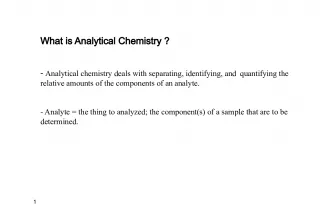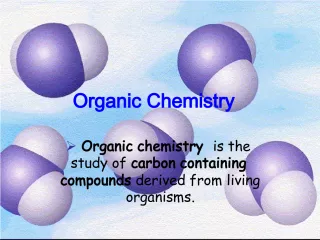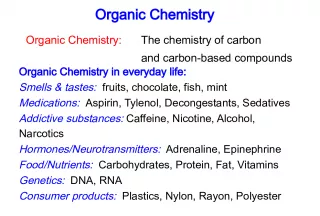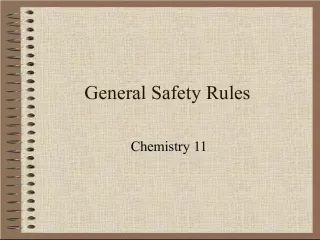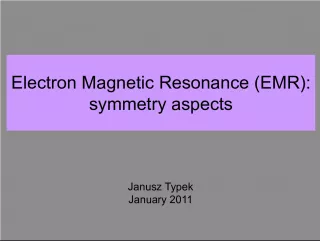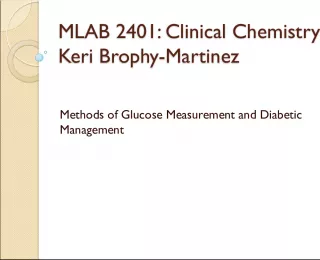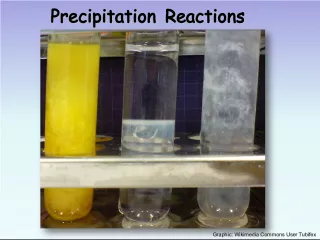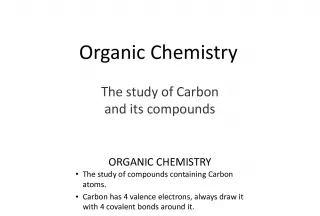Additional Aspects of Aqueous Equilibria Chemistry


This chapter in "The Central Science" 13th edition by Theodore L. Brown explores further topics related to aqueous equilibria, including solubility, complex ions, and acid-base titrations.
- Uploaded on | 1 Views
-
 oswaldo
oswaldo
About Additional Aspects of Aqueous Equilibria Chemistry
PowerPoint presentation about 'Additional Aspects of Aqueous Equilibria Chemistry'. This presentation describes the topic on This chapter in "The Central Science" 13th edition by Theodore L. Brown explores further topics related to aqueous equilibria, including solubility, complex ions, and acid-base titrations.. The key topics included in this slideshow are . Download this presentation absolutely free.
Presentation Transcript
Slide1AqueousEquilibria Chapter 17 Additional Aspects of Aqueous Equilibria Chemistry, The Central Science , 10th edition Theodore L. Brown; H. Eugene LeMay, Jr.; and Bruce E. Bursten John D. Bookstaver St. Charles Community College St. Peters, MO 2006, Prentice Hall, Inc.
Slide2AqueousEquilibria March 11 • COMMON ION EFFECT 17.11, 13, 15 • BUFFER PROBLEMS 17, 19, 23, 25 • TITRATIONS 31 to 39 odd, 43
Slide3AqueousEquilibria The Common-Ion Effect • Consider a solution of acetic acid: • If acetate ion is added to the solution, Le Châtelier says the equilibrium will shift to the left. HC 2 H 3 O 2 ( aq ) + H 2 O ( l ) H 3 O + ( aq ) + C 2 H 3 O 2 − ( aq)
Slide4AqueousEquilibria The Common-Ion Effect “The extent of ionization of a weak electrolyte is decreased by adding to the solution a strong electrolyte that has an ion in common with the weak electrolyte.”
Slide5AqueousEquilibria The Common-Ion Effect Calculate the fluoride ion concentration and pH of a solution that is 0.20 M in HF and 0.10 M in HCl. K a for HF is 6.8 10 − 4 . [H 3 O + ] [F − ] [HF] K a = = 6.8 10 -4
Slide6AqueousEquilibria The Common-Ion Effect Because HCl, a strong acid, is also present, the initial [H 3 O + ] is not 0, but rather 0.10 M . [HF], M [H 3 O + ], M [F − ], M Initially 0.20 0.10 0 Change − x + x + x At Equilibrium 0.20 − x 0.20 0.10 + x 0.10 x HF ( aq ) + H 2 O ( l ) H 3 O + ( aq ) + F − ( aq )
Slide7AqueousEquilibria The Common-Ion Effect = x 1.4 10 − 3 = x (0.10) ( x ) (0.20) 6.8 10 − 4 = (0.20) (6.8 10 − 4 ) (0.10)
Slide8AqueousEquilibria The Common-Ion Effect • Therefore, [F − ] = x = 1.4 10 − 3 [H 3 O + ] = 0.10 + x = 1.01 + 1.4 10 − 3 = 0.10 M • So, pH = − log (0.10) pH = 1.00
Slide9AqueousEquilibria Buffers: • Solutions of a weak conjugate acid-base pair. • They are particularly resistant to pH changes, even when strong acid or base is added.
Slide10AqueousEquilibria Example Write the reaction that occurs in a buffer solution containing HF/F - when: 1. H + is added H + + F - HF 2. OH - is added OH - + HF F - + H 2 O
Slide11AqueousEquilibria Buffers If a small amount of hydroxide is added to an equimolar solution of HF in NaF, for example, the HF reacts with the OH − to make F − and water.
Slide12AqueousEquilibria Buffers If acid is added, the F − reacts to form HF and water.
Slide13AqueousEquilibria Buffer Calculations Consider the equilibrium constant expression for the dissociation of a generic acid, HA: [H 3 O + ] [A − ] [HA] K a = HA + H 2 O H 3 O + + A −
Slide14AqueousEquilibria Buffer Calculations Rearranging slightly, this becomes [A − ] [HA] K a = [H 3 O + ] Taking the negative log of both side, we get [A − ] [HA] − log K a = − log [H 3 O + ] + − log p K a pH acid base
Slide15AqueousEquilibria Buffer Calculations • So p K a = pH − log [base] [acid] • Rearranging, this becomes pH = p K a + log [base] [acid] • This is the Henderson – Hasselbalch equation .
Slide16AqueousEquilibria MARCH 14 • BUFFER PROBLEMS • Calculation of the ph of a buffer • Buffer capacity • Addition of strong acid or bases to buffers • BUFFER PROBLEMS 17, 19, 23, 25 • TITRATIONS a)Strong acid and Strong base • b ) Weak acid – Strong Base • Titration of polyprotic Acids • TITRATIONS problems 31 to 39 odd, 43
Slide17AqueousEquilibria Henderson – Hasselbalch Equation What is the pH of a buffer that is 0.12 M in lactic acid, HC 3 H 5 O 3 , and 0.10 M in sodium lactate? K a for lactic acid is 1.4 10 − 4 .
Slide18AqueousEquilibria Henderson – Hasselbalch Equation pH = p K a + log [base] [acid] pH = − log (1.4 10 − 4 ) + log (0.10) (0.12) pH = 3.85 + ( − 0.08) pH = 3.77
Slide19AqueousEquilibria Buffer Capacity • The amount of acid of base the buffer can neutralize before the pH begins to change to an appreciable degree. It depends on the amount of acid and base from which the buffer is made. • The pH of the buffer depends on the Ka of the acid, and on the relative concentrations of acid and base.
Slide20AqueousEquilibria Example • A solution 1M in HA, 1M in NaA will have its pH=Ka. • A solution .1M in HA and .1M in NaA will have SAME pH (Ka) but the first one will have greater buffer capacity.
Slide21AqueousEquilibria pH Range • The pH range is the range of pH values over which a buffer system works effectively. • It is best to choose an acid with a p K a close to the desired pH. • In practice if the concentrations of one component of the buffer is 10 times the concentration of the other component the buffering action is poor.
Slide22AqueousEquilibria Addition of Strong Acids or Bases to Buffers • The amount of strong acid or base added results in a neutralization reaction: X - + H 3 O + HX + H 2 O HX + OH - X - + H 2 O. • By knowing how much H 3 O + or OH - was added (stoichiometry) we know how much HX or X - is formed. • With the concentrations of HX and X - (note the change in volume of solution) we can calculate the pH from the Henderson-Hasselbalch equation or the original equilibrium expression (ICE chart).
Slide23AqueousEquilibria When Strong Acids or Bases Are Added to a Buffer… …it is safe to assume that all of the strong acid or base is consumed in the reaction.
Slide24AqueousEquilibria Calculating pH Changes in Buffers A buffer is made by adding 0.300 mol HC 2 H 3 O 2 and 0.300 mol NaC 2 H 3 O 2 to enough water to make 1.00 L of solution. The pH of the buffer is 4.74. Calculate the pH of this solution after 0.020 mol of NaOH is added.
Slide25AqueousEquilibria Calculating pH Changes in Buffers Before the reaction, since mol HC 2 H 3 O 2 = mol C 2 H 3 O 2 − pH = p K a = − log (1.8 10 − 5 ) = 4.74
Slide26AqueousEquilibria Calculating pH Changes in Buffers The 0.020 mol NaOH will react with 0.020 mol of the acetic acid: HC 2 H 3 O 2 ( aq ) + OH − ( aq ) C 2 H 3 O 2 − ( aq ) + H 2 O ( l ) HC 2 H 3 O 2 C 2 H 3 O 2 − OH − Before reaction 0.300 mol 0.300 mol 0.020 mol After reaction 0.280 mol 0.320 mol 0.000 mol
Slide27AqueousEquilibria Calculating pH Changes in Buffers Now use the Henderson – Hasselbalch equation to calculate the new pH: pH = 4.74 + log (0.320) (0. 200) pH = 4.74 + 0.06 pH = 4.80
Slide28AqueousEquilibria Addition of Strong Acid or Base to a Buffer 1. Determine how the neutralization reaction affects the amounts of the weak acid and its conjugate base in solution. 2. Use the Henderson – Hasselbalch equation to determine the new pH of the solution.
Slide29AqueousEquilibria Examples 1. Consider a buffer prepared by placing 0.60 moles of HF (K a = 7.2 x 10 -4 ) and 0.48 moles of NaF in a 1.00 L solution. a. Calculate the pH of the buffer b. Calculte the pH after the addition of 0.08 moles of HCl c. Calculate the pH after the addition of a total of 0.16 moles of HCl d. Calculate the pH after the addition of 0.10 moles of NaOH.
Slide30AqueousEquilibria 2. Consider a buffer containing 0.78 moles of HC 2 H 3 O 2 (Ka = 1.8 x 10-5) and 0.67 moles of NaC 2 H 3 O 2 in 1.00 L of solution. a. Calculate the pH of the buffer solution. b. Calculate the pH after the addition of 0.10 moles of HNO 3 . c. Calculate the pH after the addtiion of a total of 0.20 moles of HNO 3 . d. Calculate the pH after the addition of 0.10 moles of NaOH.
Slide31AqueousEquilibria Titration A known concentration of base (or acid) is slowly added to a solution of acid (or base).
Slide32AqueousEquilibria Titration A pH meter or indicators are used to determine when the solution has reached the equivalence point , at which the stoichiometric amount of acid equals that of base.
Slide33AqueousEquilibria Titration of a Strong Acid with a Strong Base From the start of the titration to near the equivalence point, the pH goes up slowly.
Slide34AqueousEquilibria Titration of a Strong Acid with a Strong Base Just before and after the equivalence point, the pH increases rapidly.
Slide35AqueousEquilibria Titration of a Strong Acid with a Strong Base At the equivalence point, mol acid = mol base, the solution contains only water and the salt from the cation of the base and the anion of the acid.
Slide36AqueousEquilibria Titration of a Strong Acid with a Strong Base As more base is added, the increase in pH again levels off.
Slide37AqueousEquilibria Titration of a Weak Acid with a Strong Base • Unlike in the previous case, the conjugate base of the acid affects the pH when it is formed. • The pH at the equivalence point will be >7. • Phenolphthalein is commonly used as an indicator in these titrations.
Slide38AqueousEquilibria Titration of a Weak Acid with a Strong Base At each point below the equivalence point, the pH of the solution during titration is determined from the amounts of the acid and its conjugate base present at that particular time.
Slide39AqueousEquilibria Titration of a Weak Acid with a Strong Base With weaker acids, the initial pH is higher and pH changes near the equivalence point are more subtle.
Slide40AqueousEquilibria Titration of a Weak Base with a Strong Acid • The pH at the equivalence point in these titrations is < 7. • Methyl red is the indicator of choice.
Slide41AqueousEquilibria Titrations of Polyprotic Acids In these cases there is an equivalence point for each dissociation.
Slide42AqueousEquilibria Solubility Products Consider the equilibrium that exists in a saturated solution of BaSO 4 in water: BaSO 4 ( s ) Ba 2+ ( aq ) + SO 4 2 − ( aq )
Slide43AqueousEquilibria Solubility Products The equilibrium constant expression for this equilibrium is K sp = [Ba 2+ ] [SO 4 2 − ] where the equilibrium constant, K sp , is called the solubility product .
Slide44AqueousEquilibria Solubility Products • K sp is not the same as solubility. • Solubility is generally expressed as the mass of solute dissolved in 1 L (g/L) or 100 mL (g/mL) of solution, or in mol/L ( M ).
Slide45AqueousEquilibria Factors Affecting Solubility • The Common-Ion Effect If one of the ions in a solution equilibrium is already dissolved in the solution, the equilibrium will shift to the left and the solubility of the salt will decrease. BaSO 4 ( s ) Ba 2+ ( aq ) + SO 4 2 − ( aq )
Slide46AqueousEquilibria Factors Affecting Solubility • pH If a substance has a basic anion, it will be more soluble in an acidic solution. Substances with acidic cations are more soluble in basic solutions.
Slide47AqueousEquilibria Factors Affecting Solubility • Complex Ions Metal ions can act as Lewis acids and form complex ions with Lewis bases in the solvent.
Slide48AqueousEquilibria Factors Affecting Solubility • Complex Ions The formation of these complex ions increases the solubility of these salts.
Slide49AqueousEquilibria Factors Affecting Solubility • Amphoterism Amphoteric metal oxides and hydroxides are soluble in strong acid or base, because they can act either as acids or bases. Examples of such cations are Al 3+ , Zn 2+ , and Sn 2+ .
Slide50AqueousEquilibria Will a Precipitate Form? • In a solution, If Q = K sp , the system is at equilibrium and the solution is saturated. If Q < K sp , more solid will dissolve until Q = K sp . If Q > K sp , the salt will precipitate until Q = K sp .
Slide51AqueousEquilibria Selective Precipitation of Ions One can use differences in solubilities of salts to separate ions in a mixture.

